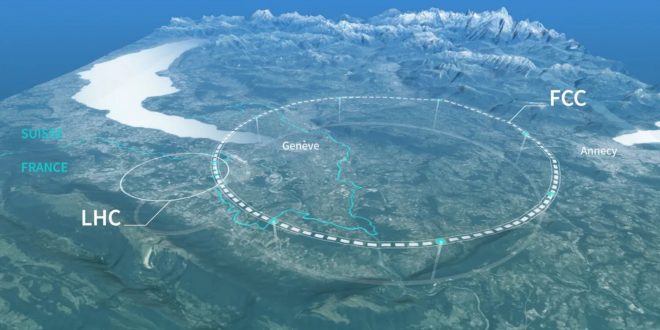In early February, CERN’s council convened a specialized meeting to deliberate on a crucial matter regarding its future: the construction of the upcoming particle accelerator. CERN houses the Large Hadron Collider (LHC), which is widely regarded as the most intricate singular apparatus on the planet. The Future Circular Collider (FCC) is the proposed design for the next-generation international collaboration particle smasher. It is three times the length of the LHC.
The Large Hadron Collider (LHC) is a remarkable scientific apparatus. The facility consists of a 27-kilometer (16.77-mile) ring of superconducting magnets located beneath Geneva, at the border between France and Switzerland. The functionality of the LHC is enabled by the utilization of superconductive magnets, which are maintained at a temperature just above absolute zero. These magnets encompass two colossal tubes that are situated within an ultrahigh vacuum environment. The temperature and lack of matter inside are even lower than in the vast expanse of interstellar space.
Within the tubes, protons (or occasionally heavy ions) swiftly traverse, nearing the speed of light, ultimately colliding within one of the four experiments. During these collisions, unique conditions arise that have not been observed since the early stages of the Big Bang, resulting in the formation of a variety of intriguing particles. One notable accomplishment was the identification of the Higgs boson, a particle that is responsible for providing mass to other particles in a simplified manner.
However, the capabilities of the LHC are constrained. Researchers have been contemplating the next course of action, as there are energies that surpass the capabilities of such a machine. In recent years, CERN initiated an inquiry into the development of the next particle accelerator. After extensive discussions among particle physicists from Europe and around the globe, a consensus was reached on the design of a larger circular apparatus known as the Future Circular Collider.
The proposed accelerator will have a length of 90 kilometers (56 miles), which is three times longer than the LHC. Additionally, it will be built twice as deep. If given the green light, the project is slated to commence construction in the early 2030s. Subsequently, it will initiate electron collisions in the 2040s, followed by proton collisions in the 2070s.
The objective is to investigate the energy ranges where concrete evidence of dark matter and dark energy could potentially be discovered. The energies that the LHC can achieve are limited, preventing the protons in its beams from being pushed further. Expanding the scope, one possible strategy involves constructing a larger detector. The total cost amounts to 15 billion Swiss francs, equivalent to approximately $17.2 billion.
However, the proposed plan has faced criticism from some quarters. Some experts have expressed concerns about the project’s uncertain outcome in terms of providing evidence for the existence of dark matter and dark energy, which the LHC has not yet been able to do. A similar argument could have been made regarding the Large Hadron Collider and the subsequent discovery of the Higgs Boson.
Additionally, the LHC has achieved numerous other breakthroughs apart from the discovery of that particle. Over the course of a decade, nearly 3,000 scientific papers were published based on the experiments conducted, significantly advancing our comprehension of particle physics.
There are individuals within the scientific community, as well as policymakers and media outlets, who have raised concerns about the financial implications of the proposed facilities. They argue that the cost may be seen as wasteful without considering the potential benefits it could bring to the building and manufacturing sectors in all the countries involved with CERN. Thanks to an investment in the organization, you are currently able to read this, as CERN is the birthplace of the World Wide Web.
Another point of contention is the argument that the funds would be better allocated towards environmental initiatives aimed at addressing the pressing issue of climate change. In addition to dispelling the misconception that these two concepts are incompatible, it is worth noting that the European Union, which encompasses numerous CERN members, allocated a budget for fossil fuel subsidies in 2022 that was nearly 100 times greater than the proposed plan’s cost.
In the end, the determination of whether the project aligns with CERN’s requirements lies in the hands of the countries that contribute to CERN’s membership. A research project examining the viability of the Federal Communications Commission (FCC) is scheduled for completion in the coming year. The European Strategy for Particle Physics is set to undergo an update in 2026, potentially impacting future plans. If the plans are solid, the FCC could potentially receive approval in 2028, paving the way for the commencement of a new era in particle physics.
 Tech Gadget Central Latest Tech News and Reviews
Tech Gadget Central Latest Tech News and Reviews




